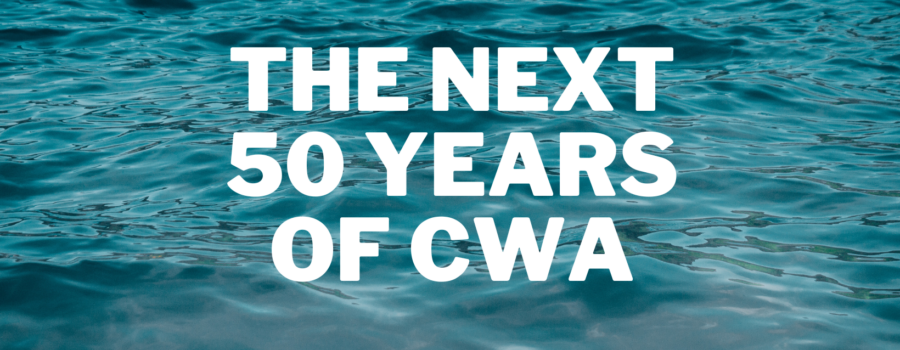The Next 50 Years of the Clean Water Act
By: Evan Isaacson
Last October, on the 50th anniversary of the Senate’s introduction of the bill that became the Clean Water Act, we reflected on the deliberations behind the landmark legislation. As we celebrate 50 years since the Clean Water Act became law on October 18, 1972, it is time to take stock of where the law stands today and what its future might look like 50 years from now.
One could make an equally persuasive argument that the Clean Water Act was either an incredible success story or a total failure. Both statements are arguably true. The nation’s waterways are no longer open sewers or conduits of industrial waste streams and look nothing like they did in the 1950s and 1960s. On the other hand, far too few of our rivers and lakes are fishable and swimmable – the statute’s goals – and we are not even remotely close to the future Congress envisioned where water pollution was fully eliminated.
Today, we do have a complex regulatory system that ensures any facility discharging pollution into our waters only does so after an engineer has written a permit that minimizes or otherwise limits how much can be discharged. And billions of dollars are handed out to local governments each year to help finance water infrastructure upgrades and pollution control projects. But at the same time, we also have countless facilities (well, you can count some of them here) presently violating their Clean Water Act permits with impunity and hundreds of cities with antiquated or failing water infrastructure in desperate need of capital infusions.
Perhaps the very best gauge of progress under the Clean Water Act is right here in the Chesapeake Bay. Why? Because just about every branch of government at every level has given the Chesapeake Bay special status under the Clean Water Act or additional resources to enable the restoration of this national treasure. If any waterway should be restored to health, it seems like it ought to be here.
The Bay benefits from one of the most sophisticated ecosystem restoration plans in the world, one of the most complex watershed models in the world, a large annual appropriation from the federal budget, and extensive cooperation from numerous government agencies, academic institutions, and hundreds of private and nonprofit organizations. The Bay is, and should be, at the cutting edge of efforts to restore water quality in the United States under the Clean Water Act – or frankly anywhere in the world, under any statutory cleanup scheme.
And yet, after more than a decade of working under what was supposed to be the last and best hope for finally restoring the Chesapeake Bay, after decades of false starts and failed efforts, state and federal officials are now for the first time admitting defeat and acknowledging that the Bay will not be on its way toward health in 2025. What is standing in the way of the Chesapeake Bay’s restoration is the same thing that has prevented the Clean Water Act from reaching its full potential and achieving fishable, swimmable waters free of pollution, in waterways all across the country.
So, what is standing in the way of progress under the Clean Water Act? A noncomprehensive list of top line items would include:
- Inadequate controls or programmatic efforts under the law of pollution to deal with diffuse “nonpoint sources” such as runoff from agricultural fields and the vast fields of pavement in our urban areas.
- The need to restore the original levels of funding for upgrading wastewater infrastructure that Congress approved in the decade after the Clean Water Act was passed (and extending funding to stormwater infrastructure as well).
- An infusion of resources for the Environmental Protection Agency to enable the agency to provide greater oversight of the Act’s implementation by states and greater direct enforcement and implementation where the states fail to do their job.
Beyond these and other needs for rejuvenating the Clean Water Act and helping to meet its original goals, it is also important to reflect on how different the world is today from 50 years ago and what that means for the future of the Act. The elephant in the room here is obviously climate change. When Congress passed the Clean Water Act, most members of Congress had never heard of the greenhouse effect on the climate (though historians point out that there were sporadic hearings and internal memos in Congress and the White House in the 1960s). In fact, carbon dioxide levels in the atmosphere have risen more than twice as much in the last 50 years as they had from the dawn of the industrial revolution centuries ago up to 1970.
All of the climatic changes we’ve experienced to date and the vastly more severe changes that will be coming certainly have the potential to upend decades of progress in improving water quality and make the fishable and swimmable goals of the Clean Water Act that much more difficult to reach. This is because warmer temperatures, especially when combined with sea level rise, increased erosion, and the loss of newly submerged wetlands, can decimate the entire aquatic ecosystems of some watersheds.
So even if we achieve one of the basic goals of the Clean Water Act – eliminating pollution – it might be simultaneously possible that we cannot achieve the other goals – fishable and swimmable waters – in many of the nation’s waters. That is not to say we should not try. After all, it might be the case that the elimination (or substantial reduction) of pollution will make our aquatic ecosystems more resilient to the effects of climate change. Moreover, if we are soon able to dramatically slash greenhouse gas emissions in the coming decades, we could avoid some of the most severe impacts. Even if we do face a world of runaway climate change later in the 21st century, it is nevertheless important to control water pollution due to the major implications for human health that come along with eliminating pollution.
The other major societal change since 1972 that must be mentioned is our nation’s demographic and socioeconomic changes. As mentioned previously, some of the greatest features of the Clean Water Act are the public participation and public enforcement rights that Congress provided to the American people. The right to enforce the Clean Water Act and the obligation of the U.S. EPA and state environmental agencies to maximize the opportunity for the public to participate in the process of implementing the law have dramatically altered the course of the Clean Water Act’s implementation and development over the last half-century and resulted in countless water quality wins that simply would not have been possible without that unique right.
However, it is also undoubtedly true that the benefits and burdens of pollution and efforts to reduce it have not fallen equally upon different members of society. When the Clean Water Act was enacted, the difference between rich and poor was far narrower than it is now. A much greater percentage of Americans lived in similar places and in similar fashions, more equally exposed to pollution. Today, there is a vast difference in the degree of exposure to industrial pollution with some communities right at the fencelines of industrial plants, while others are able to afford to escape to much cleaner locations. This has created environmental injustices that cannot be attacked without fundamental reforms – both within and outside the scope of the Clean Water Act.
In the context of the Clean Water Act, we need to restore our environmental agencies to full capacity in order to ensure they are able to give full effect to this law. After all, the Clean Water Act’s overarching goal is to eliminate pollution (everywhere) and ensure that (all) waters are fishable and swimmable. If Clean Water Act permits are written adequately and fully enforced, that would mean a substantial reduction in the amount of toxic pollutants flowing through communities that are most impacted by industrial pollution today. And if our regulatory agencies were to give greater effect to the Clean Water Act’s public participation rights, the public today would have significantly greater access to the decision-making processes that affect the health of their communities.
At CLA, we envision this future and it guides our daily work. We receive requests for legal assistance to help communities achieve the future they envision for themselves. But we also work proactively through our legal and policy work to shape the way the law is carried out. If we are successful, we will make sure that the Clean Water Act is used to help build a climate-resilient future and one that gives everyone in every community access to fishable and swimmable waters. Please join us in celebrating the Clean Water Act’s 50th birthday and please help support our work. We do our work for you and cannot do it without you.



![[UPDATED 04/02/20] Q&A: EPA suspends environmental safeguards due to COVID-19. What does this mean for the Bay?](https://www.chesapeakelegal.org/wp-content/uploads/2020/03/BaltimoreFIshKill2006CreditElizaSteinmeier-scaled-300x200.jpg)

